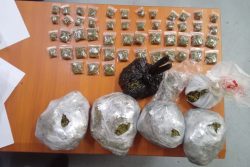On Monday last around 6 pm accused offenders housed at the Juvenile Detention Centre in Sophia, Georgetown, somehow managed to set a mattress on fire, which resulted in minor injury—from smoke inhalation—to three inmates of the facility. The police, in a terse release on the same day, stated in part: “Alert ranks on duty, responding to the smell of smoke emanating from the cell [where the fire was started] quickly extinguished the blaze. No damage was done to the facility.” The release did say at the beginning that an investigation had been launched into the incident and no doubt the police will release the findings of that investigation once it is completed.
However, this is by no means all that could or should be done with regard to this incident and one can only hope that those in authority, the police included, view the events of Monday evening as a cautionary tale.
It is worth pointing out, even at the risk of coming over as redundant, that it was fire set to mattresses in the Camp Street Georgetown men’s prison last year March, which resulted in 17 fatalities, all as a result of smoke inhalation, the findings of an investigation had said. There is a possibility that the Sophia centre fire was a copycat of the March 2016 fire. While the ‘why’ and the ‘how’ of it would have to be answered by the investigation, the ‘what’ and the ‘what-ifs’ boggle the mind.
What, for example, would lead juvenile detainees to start a mattress fire, knowing that a similar conflagration had resulted in deaths? What if the officers responding were unable to put out the fire? And suppose it had occurred late at night when inmates might have been asleep?
It is a known fact that smoke inhalation is the number one cause of fire related deaths. When people die in house (or other buildings) fires, even if their bodies are burnt, they most likely would have died from inhaling the toxic smoke produced by the fire.
Articles such as mattress foam, painted wood or even different clothing materials, among others, when combusted, produce smoke that can contain carbon monoxide along with other harmful gases. Their toxicity magnifies when they are burned in an enclosed area. It takes just 30 seconds for a person to be affected by smoke inhalation, becoming lightheaded and/or short of breath. If the person is awake, he/she would likely try to move away from the smoke, or seek fresh air/oxygen. If the person is asleep, he/she could easily slip into unconsciousness without waking up. It is that serious.
One hopes that while the investigation is being conducted, efforts are being/have been made to ensure that juvenile detainees have no access to any prohibited materials whatsoever and that they are watched more closely, lest they cause harm to themselves and others.
The point must be made here too that the Sophia Juvenile Holding Centre, constructed at a cost of $37.6 million and formally declared open by then home minister Mr Clement Rohee in April 2011, is the only one of its kind in Guyana. It was completed three years after the Juvenile Offenders Act was amended and intended to house minors—between the ages of 10 and 17 years old—who would have been accused of being in conflict with the law. Mr Rohee had said at the time that it was one of several that would be constructed to hold juveniles pending charges, on remand or “who have completed the period of their sentence and are awaiting rehabilitation.”
Six years later, it remains the sole facility housing juveniles of both sexes—though in separate sections—those charged with major crimes such as murder or armed robbery as well as those charged with wandering. Children who live in Berbice, Essequibo and other areas far from the city, once charged or arrested have to be transported to the Sophia facility, from where they are taken to court in the various regions as necessary. This newspaper has reported on this in the past. It has also noted ad nauseam that despite several lobbies mounted against it, the so-called crime of wandering remains on the law books and punishment is meted out to children thus accused even in cases where they might in fact be running away from home because of abuse.
Advocacy to end this as well as for at least one juvenile holding facility in each region must be raised again and continued until government does what it must to ensure that when minors are arrested, they are kept safe.








